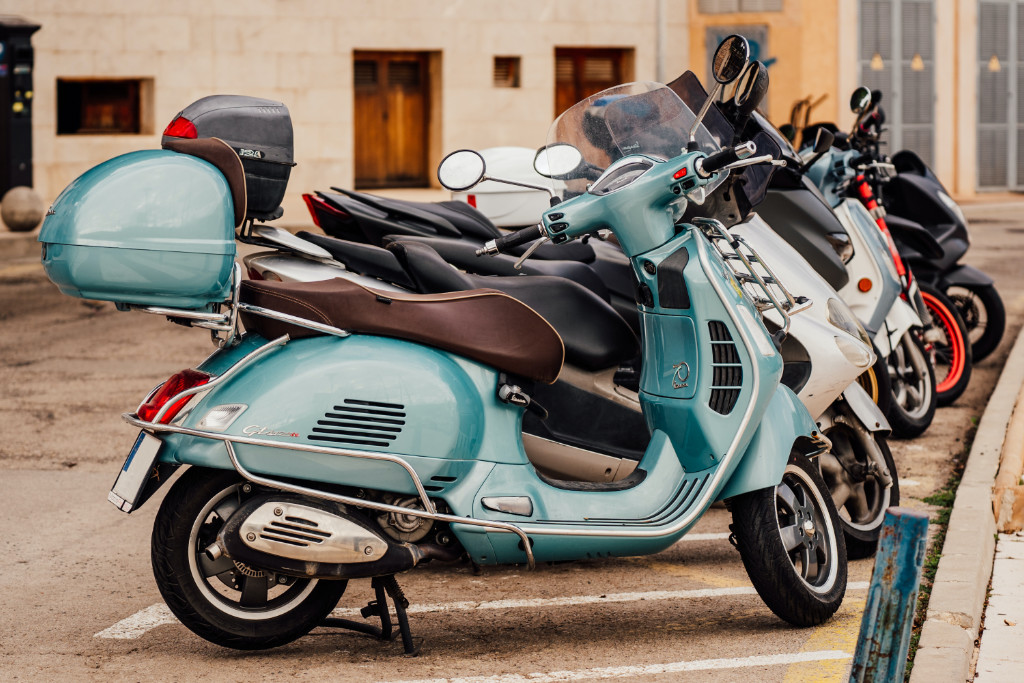The continuously variable power transmission on the Vespa is provided by the variomatic. This type of drive has several advantages over a manual gearbox. These are the high efficiency and low maintenance. Since the power is transmitted via a V-belt, it is almost noiseless. This technology is not so well known. Therefore, the mode of operation should be described in more detail.
The core piece is a so-called variator. The name comes from the fact that it is a variable power transmission. This technology has been around for a very long time. It was already used in the sixties of the last century in construction and agricultural machines in order to always be able to drive at an optimal speed. In a Vespa, however, the components are much more delicate. In addition, the speed is no longer controlled manually, but depends on the engine speed.
A variator is a V-belt drive with two split V-belt pulleys each. The two halves of the pulleys can be moved axially. Due to the design, the V-belt sinks slightly deeper into the pulley if the two halves move away from each other. This causes the diameter to vary. Since the two halves of the second V-belt pulley move axially in the opposite direction at the same time, the transmission ratio changes continuously.
This is how power transmission works on a Vespa
On the engine side, or more precisely directly on the crankshaft, there is a variator pulley with small rollers on the back. The rollers are located in guides. If the engine speed increases, the rollers push outwards due to centrifugal force. This moves the movable half of the variator disc towards the fixed half.
On the drive side there is a centrifugal clutch. This is more like a drum brake in its design. By increasing the speed, the jaws press against the inside of the drum and thus provide the frictional connection. As a result, the power is transmitted continuously to the rear wheel. Therefore, only a little turn of the throttle grip is needed to get the Vespa moving.
What are the advantages and disadvantages of this technology?
A big advantage is that the Vespa can never stall when starting up. The scooter starts moving smoothly in any situation. The interaction between the clutch and the operation of the throttle does not need to be practised. Comfort is very high, so there is great pleasure in riding.
Another advantage is that hardly any power is lost in the transmission. The efficiency of such a power transmission is about 95 percent. This is an enormous advantage, especially for smaller scooters with a low engine power.
There are hardly any disadvantages. The only disadvantage that could be significant is that no particularly sporty driving style is possible. On two-wheelers equipped with a manual gearbox, it is possible to ride in low gears at high revs to achieve brisk acceleration. When overtaking, it may be possible to shift down a gear to pass the slower vehicle more quickly. This is not possible with a variomatic transmission. However, those who drive a Vespa usually do not attach great importance to a sporty driving style anyway. It is usually about enjoying freedom and relaxation.
How is the belt drive of the Vespa maintained?
The drive of a Vespa is almost maintenance-free. Basically, this power transmission requires no maintenance. In addition, there is very little wear and tear. Such a V-belt drive can achieve a mileage of 50,000 km or more. But even this is not a problem, because it can be replaced by the owner. Only two small special tools are required to lock the clutch disc and the V-belt pulley on the crankshaft. Only the cover has to be removed. The two V-belt pulleys are fixed with the special tools and then removed with suitable sockets. When changing the drive belt, the centrifugal weights should also be replaced at the same time. The work is not particularly time-consuming and can be done within half an hour.
When servicing a Vespa, however, you should always make sure that the engine speed is correctly adjusted at idle. If it is set a little too high, the clutch can seize. Then it is no longer possible to disengage the clutch safely.

Which Vespa models are equipped with a continuously variable transmission?
Meanwhile, almost all Vespa models are equipped with a continuously variable transmission. These include the GTS, GTL, GTV and many more. Various Vespa models from 50 to 300 cc are equipped with a variator.



